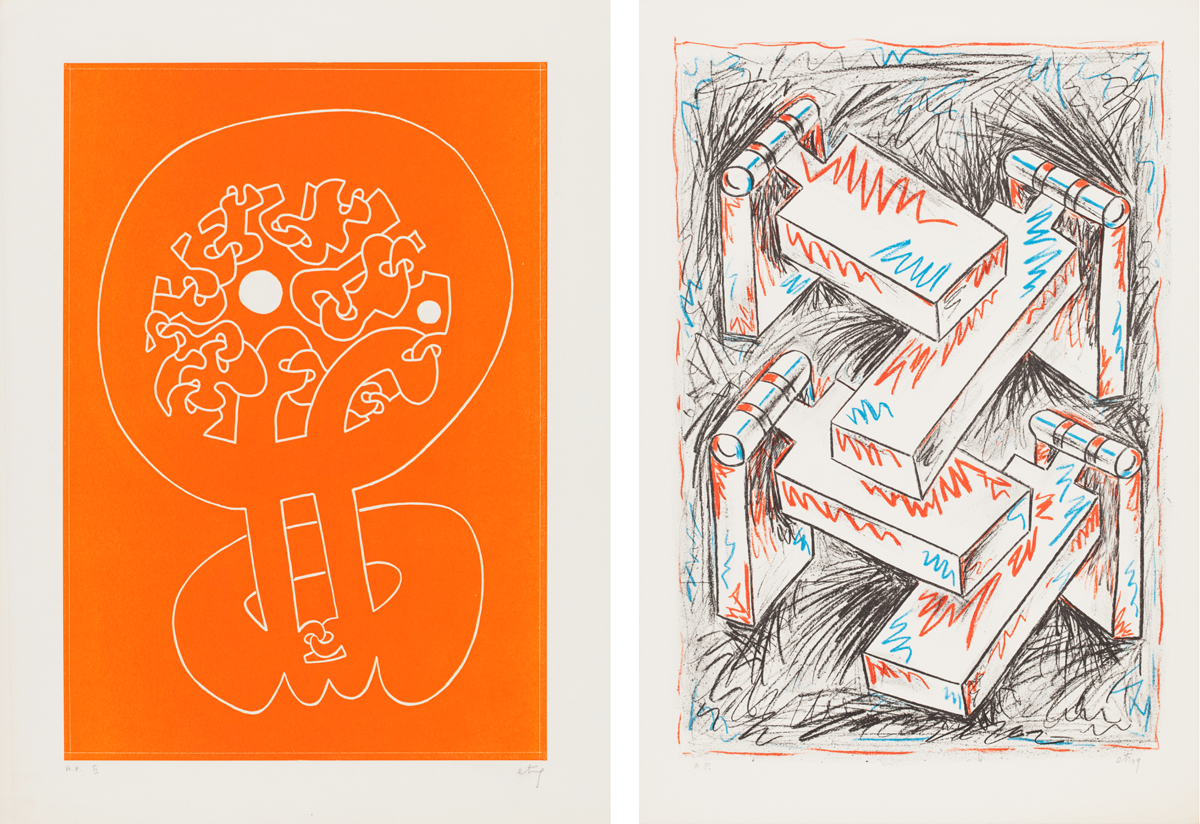Sorel Etrog, Untitled Orange, 1965, intaglio on paper, A.P. II. Collection of the MacLaren Art Centre. Gift of the artist, 1999. Photo: Andre Beneteau (left); Sorel Etrog, Hingescape I, 1978, lithograph on paper, A.P. Collection of the MacLaren Art Centre. Gift of the artist, 1999. Photo: Andre Beneteau (right)
Romanian-born Israeli-Canadian artist Sorel Etrog (1933-2014) is an interesting and prolific figure in Canadian art. He is known for his life-size and larger than life bronze sculptures, and has work in museum and private collections all over the world. In addition to accolades such as an Order of Canada designation and a place representing Canada at the 1966 Venice Biennale, there is so much more to Etrog than many of us realize. Here are five things you may not have known about this important Canadian artist.
1. His grandfather was his earliest influence
Although Etrog’s stylistic periods were defined by a broad range of inspiration, his earliest influence was his grandfather, who worked as a carpenter from the family’s shared home outside Iaşi in the then Kingdom of Romania. Etrog recalls this period of his life with great fondness: “For me his woodshop was like a shrine. The smell of wood, glue, and stain filled my nostrils the day I was born and became a sacred part of my childhood. My dream was that one day I’d be allowed to use some of his tools or even have some of my own.”[1]
As a teenager studying at the Arts Institute for Painting and Sculpture in Tel Aviv, Etrog’s youthful fascination with his grandfather’s work manifested itself in his “Painted Constructions”. Challenging the separation of painting and sculpture, these multilayered compositions were constructed by glueing or nailing freeform wooden panels together, which he then painted in oil and hung flat on the wall. Etrog’s early foray into three-dimensional media would later, in New York, catch the attention of Jewish-Canadian businessman Samuel J. Zacks, whose support was largely responsible for the artist’s rapid rise to fame.
2. He was forced to flee Romania during World War II
Sorel Etrog was born into a Jewish family right on the cusp of World War II. While the Kingdom of Romania had initially remained neutral, a coup in the summer of 1940 led to the rise of a new dictatorship allied with Germany and its anti-Semitic policies. Etrog’s father was one of the few men to survive the Iaşi Pogrom of 1941, during which 13,000 Romanian Jews were murdered by government forces. Violence against Jews continued throughout the war years and after witnessing such horrors, Etrog reflected that he could no longer be shocked.
After the War ended, Etrog’s family was faced with hunger, poverty, and further violence under Soviet occupation. Since his father was still recovering from injuries inflicted during the pogrom, Etrog helped his family by smuggling food under his clothes and selling goods on the black market. A failed attempt to flee Romania in 1946, left Etrog responsible for his younger sister after both his parents were arrested. The family was finally able to escape to Israel in 1950, but these early traumas would have a profound impact on the artist, who continued to question the nature of human existence for the rest of his life.
3. He was so much more than a sculptor
Though best known for his work as a sculptor, Etrog was a man of many talents—a painter, an illustrator, a filmmaker, an electronic music composer, and a playwright, among other things. He was keenly interested in literature and sought the company of some of the greatest writers, philosophers and academics of his generation. No doubt impacted by his early experiences during World War II, Etrog had an affinity for existentialist writers and thinkers such as Irish novelist Samuel Beckett and French-Romanian playwright Eugène Ionesco. These ideas informed his studio practice, which often employed the symbol of the chain link as a visual metaphor for the paradoxical forces that characterize our human condition—freedom and bondage, movement and stasis, hope and despair, life and death.
4. He created the “Genie” statuette for the Canadian Film Award
Etrog became a household name in Canada after designing the “Genie” award for the Canadian Films Awards in 1968. Earlier referred to as the “Etrog”, the bronze statuette depicted a standing torso with voluminous, straightened shapes that are reminiscent of earlier Cubist sculptures. The sculpture was initially modelled in wax in Florence and subsequently cast in bronze by the Michelucci Foundry in Pistoia, Italy.
5. His work was located at the Prime Minister’s residence on Sussex Drive
Etrog’s Dream Chamber (1976) is arguably one of his most significant works. Suggestive of an interlocked skull, the sculpture speaks to the power of imagination, and the belief that ideas can transform the mind and unlock human potential. Prime Minister Pierre Trudeau had the sculpture installed in the garden of the Prime Minister’s residence at 24 Sussex Drive in 1982. It remained there through 2017 when the MacLaren Art Centre took physical possession of the work, which Etrog had donated to the Gallery in 1999. Dream Chamber now presides over the exterior of the MacLaren’s historic 1917 Carnegie Library—a fitting tribute to a visual artist known for his collaborations with eminent literary figures.
Now that you know why Etrog was one of the greats, we invite you to discover his work in-person at the MacLaren Art Centre. In Sorel Etrog: Anatomy of Tension, we’re showcasing a selection of works on paper by the artist, drawn from our Permanent Collection. An online version of the exhibition is also available for folks who can’t make it into the Gallery.
[1] Michelle Becker, Sorel Etrog Painted Constructions 1952–1960 (Vancouver and Palm Desert, CA: Buschlen Mowat Galleries, 2006), 34.











